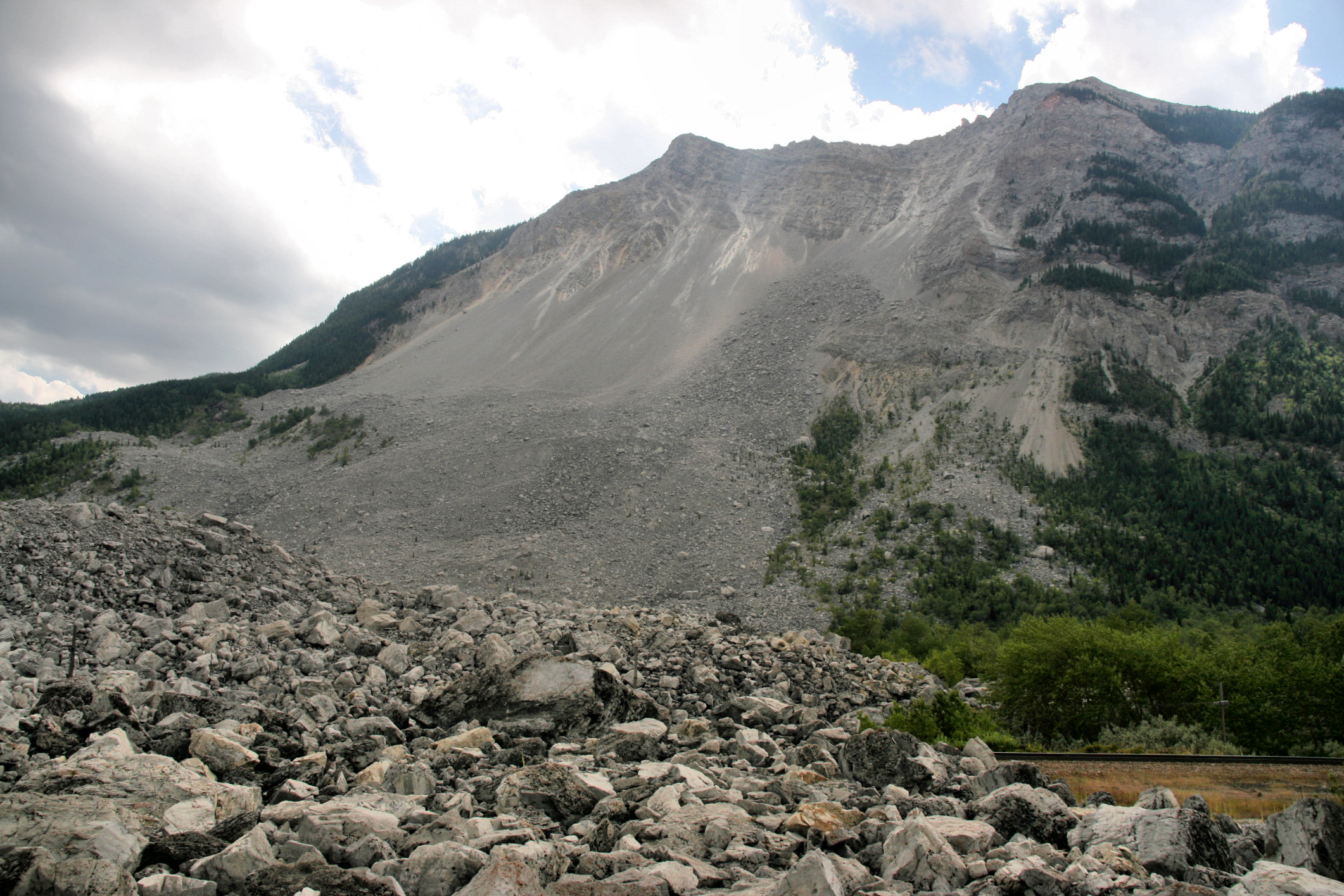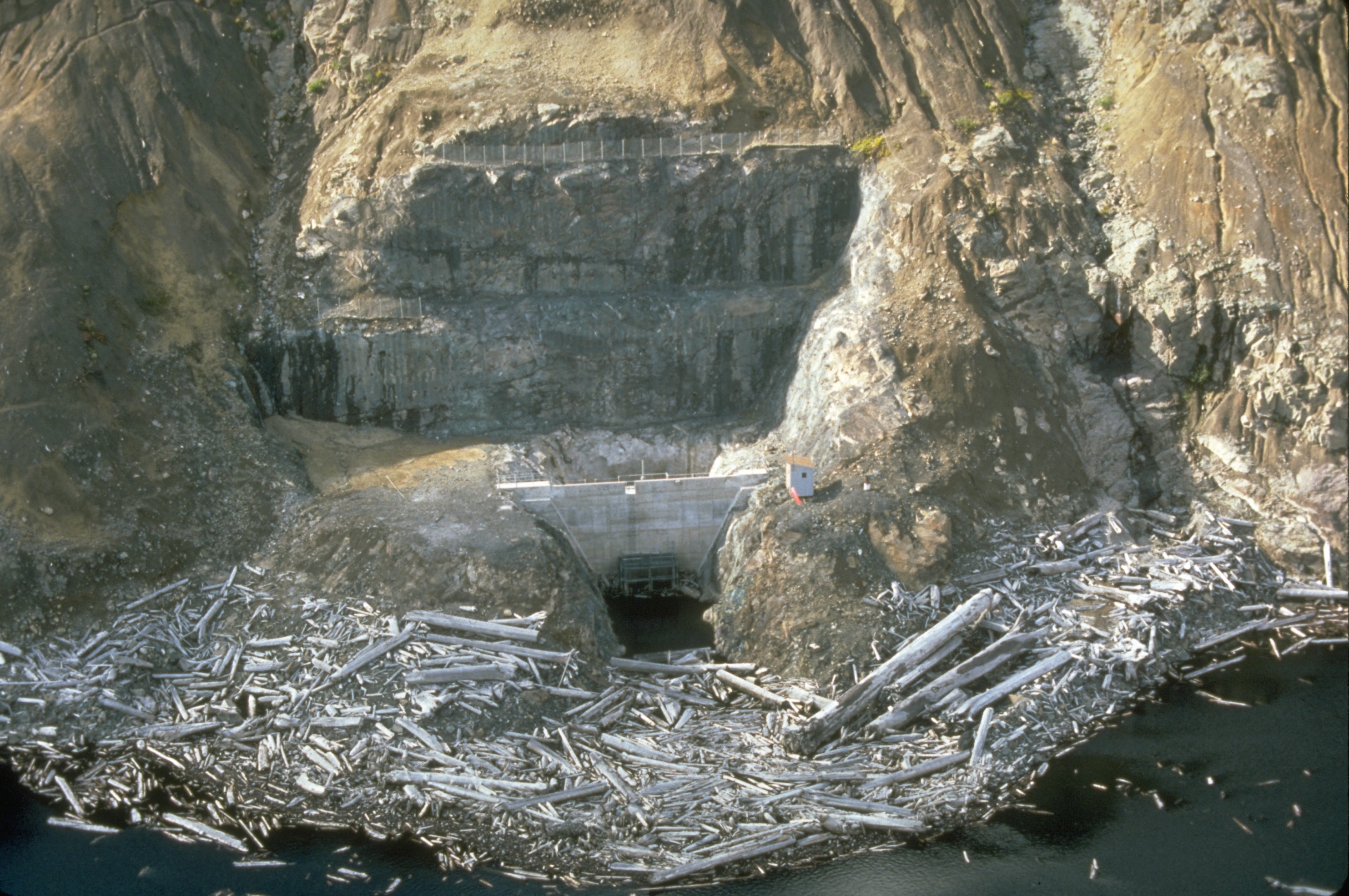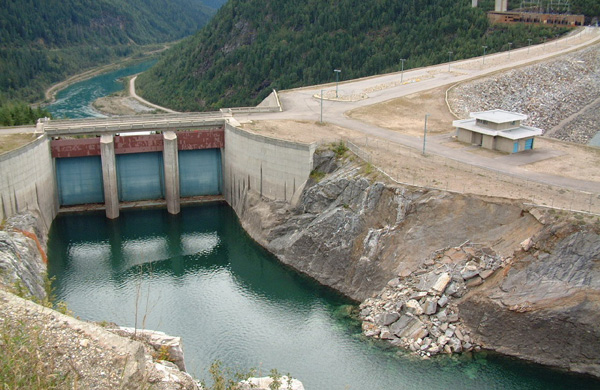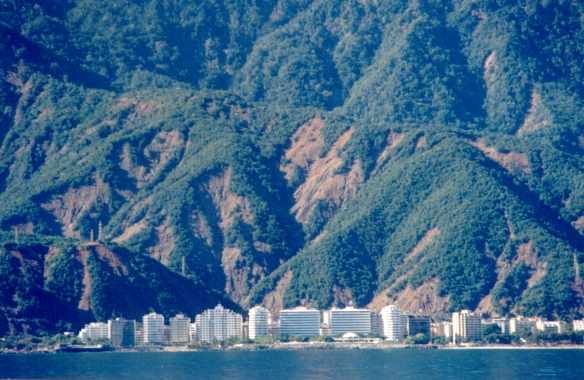|
Mud Flow
A mudflow or mud flow is a form of mass wasting involving fast-moving flow of debris that has become liquified by the addition of water. Such flows can move at speeds ranging from 3 meters/minute to 5 meters/second. Mudflows contain a significant proportion of clay, which makes them more fluid than debris flows, allowing them to travel farther and across lower slope angles. Both types of flow are generally mixtures of particles with a wide range of sizes, which typically become sorted by size upon deposition. Mudflows are often called mudslides, a term applied indiscriminately by the mass media to a variety of mass wasting events. Mudflows often start as slides, becoming flows as water is entrained along the flow path; such events are often called flow slides. Other types of mudflows include lahars (involving fine-grained pyroclastic deposits on the flanks of volcanoes) and jökulhlaups (outbursts from under glaciers or icecaps). A statutory definition of "flood-related mudsli ... [...More Info...] [...Related Items...] OR: [Wikipedia] [Google] [Baidu] |
Hill
A hill is a landform that extends above the surrounding terrain. It often has a distinct summit. Terminology The distinction between a hill and a mountain is unclear and largely subjective, but a hill is universally considered to be not as tall, or as steep as a mountain. Geographers historically regarded mountains as hills greater than above sea level, which formed the basis of the plot of the 1995 film ''The Englishman who Went up a Hill but Came down a Mountain''. In contrast, hillwalkers have tended to regard mountains as peaks above sea level. The ''Oxford English Dictionary'' also suggests a limit of and Whittow states "Some authorities regard eminences above as mountains, those below being referred to as hills." Today, a mountain is usually defined in the UK and Ireland as any summit at least high, while the official UK government's definition of a mountain is a summit of or higher. Some definitions include a topographical prominence requirement, typically ... [...More Info...] [...Related Items...] OR: [Wikipedia] [Google] [Baidu] |
Agulhas Slide ''
{{disambig ...
Agulhas (''needles'' in the Portuguese language — or ) may refer to: * Cape Agulhas, the southernmost point of Africa * L'Agulhas, a town near the Cape * Cape Agulhas Lighthouse, located at the Cape * Cape Agulhas Local Municipality, the municipality governing the area around Bredasdorp, including the Cape * Agulhas National Park, a national park protecting areas around Cape Agulhas * The Agulhas Bank, an area of ocean south of the Cape * The Agulhas Current, an ocean current off the east coast of South Africa * South African research ships: : **''S. A. Agulhas'' **''S. A. Agulhas II ''S. A. Agulhas II'' is a South African icebreaking polar supply and research ship owned by the Department of Environmental Affairs (DEA). She was built in 2012 by STX Finland Rauma shipyard in Rauma, Finland, to replace the ageing '' S. A. ... [...More Info...] [...Related Items...] OR: [Wikipedia] [Google] [Baidu] |
List Of Landslides
This list of landslides is a list of notable landslides and mudflows divided into sections by date and type. This list is very incomplete as there is no central catalogue for landslides, although some for individual countries/areas do exist. Volumes of landslides are recorded in the scientific literature using cubic kilometres (km3) for the largest and millions of cubic metres (normally given the non-standard shortening of MCM) for most events. Prehistoric landslides Note: km3 = cubic kilometre(s) Submarine landslides Note: MCM = million cubic metres; km3 = cubic kilometre(s) Pre-20th-century historic landslides Note: km3 = cubic kilometre(s); MCM = million cubic metres 20th-century landslides 1901–1950 Note: km3 = cubic kilometre(s); MCM = million cubic metres 1951–1975 Note: km3 = cubic kilometre(s); MCM = million cubic metres 1976–2000 Note: MCM = million cubic metres 21st-century landslides 2001–2010 Note: m3 = cubic metre(s); MCM = million cubic me ... [...More Info...] [...Related Items...] OR: [Wikipedia] [Google] [Baidu] |
Submarine Landslide
Submarine landslides are marine landslides that transport sediment across the continental shelf and into the deep ocean. A submarine landslide is initiated when the downwards driving stress (gravity and other factors) exceeds the resisting stress of the seafloor slope material, causing movements along one or more concave to planar rupture surfaces. Submarine landslides take place in a variety of different settings, including planes as low as 1°, and can cause significant damage to both life and property. Recent advances have been made in understanding the nature and processes of submarine landslides through the use of sidescan sonar and other seafloor mapping technology.Hampton, M & Locat, J (1996) Submarine landslides. Reviews of Geophysics, 34, 33–59.Locat, J & Lee, HJ (2002) Submarine landslides: Advances and challenges. Canadian Geotechnical Journal, 39, 193.Mason, D, Habitz, C, Wynn, R, Pederson, G & Lovholt, F (2006) Submarine landslides: processes, triggers and hazar ... [...More Info...] [...Related Items...] OR: [Wikipedia] [Google] [Baidu] |
Spirit Lake (Washington)
Spirit Lake is a lake in Skamania County, Washington, United States, located north of Mount St. Helens. It was a popular tourist destination for many years until Mount St. Helens erupted in 1980. Previously there had been six camps on the shore of Spirit Lake: Boy Scout ( Camp Spirit Lake), the Girl Scout Camp at Spirit Lake, two YMCA camps ( Camp Loowit, and Portland YMCA camp), Harmony Fall Lodge, and another for the general public. There were also several lodges accessible to visitors, including Spirit Lake Lodge and Mt. St. Helens Lodge. The latter was owned and operated by Harry R. Truman, a noted victim of the volcano's 1980 eruption. Pre-1980 eruption Prior to 1980, Spirit Lake consisted of two arms that occupied what had been the valleys of the North Fork Toutle River and a tributary. About 4,000 years ago, these valleys were blocked by lahars and pyroclastic flow deposits from Mount St. Helens to form the pre-1980 Spirit Lake. The longest branch of Spirit Lake wa ... [...More Info...] [...Related Items...] OR: [Wikipedia] [Google] [Baidu] |
Washington (state)
Washington (), officially the State of Washington, is a state in the Pacific Northwest region of the Western United States. Named for George Washington—the first U.S. president—the state was formed from the western part of the Washington Territory, which was ceded by the British Empire in 1846, by the Oregon Treaty in the settlement of the Oregon boundary dispute. The state is bordered on the west by the Pacific Ocean, Oregon to the south, Idaho to the east, and the Canadian province of British Columbia to the north. It was admitted to the Union as the 42nd state in 1889. Olympia is the state capital; the state's largest city is Seattle. Washington is often referred to as Washington state to distinguish it from the nation's capital, Washington, D.C. Washington is the 18th-largest state, with an area of , and the 13th-most populous state, with more than 7.7 million people. The majority of Washington's residents live in the Seattle metropolitan area, the center o ... [...More Info...] [...Related Items...] OR: [Wikipedia] [Google] [Baidu] |
1980 Eruption Of Mount St
__NOTOC__ Year 198 (CXCVIII) was a common year starting on Sunday (link will display the full calendar) of the Julian calendar. At the time, it was known as the Year of the Consulship of Sergius and Gallus (or, less frequently, year 951 ''Ab urbe condita''). The denomination 198 for this year has been used since the early medieval period, when the Anno Domini calendar era became the prevalent method in Europe for naming years. Events By place Roman Empire *January 28 ** Publius Septimius Geta, son of Septimius Severus, receives the title of Caesar. **Caracalla, son of Septimius Severus, is given the title of Augustus. China *Winter – Battle of Xiapi: The allied armies led by Cao Cao and Liu Bei defeat Lü Bu; afterward Cao Cao has him executed. By topic Religion * Marcus I succeeds Olympianus as Patriarch of Constantinople (until 211). Births * Lu Kai (or Jingfeng), Chinese official and general (d. 269) * Quan Cong, Chinese general and advisor ( ... [...More Info...] [...Related Items...] OR: [Wikipedia] [Google] [Baidu] |
Landslide Classification
There have been known various classifications of landslides. Broad definitions include forms of mass movement (geology), mass movement that narrower definitions exclude. For example, the ''McGraw-Hill Encyclopedia of Science and Technology'' distinguishes the following types of landslides: *fall (by undercutting) *fall (by toppling) *Slump (geology), slump *rockslide *earthflow *sinkholes, mountain side *rockslide that develops into rock avalanche Influential narrower definitions restrict landslides to slumps and translational slides in rock and regolith, not involving fluidisation. This excludes falls, topples, lateral spreads, and mass flows from the definition.Varnes D. J., Slope movement types and processes. In: Schuster R. L. & Krizek R. J. Ed., Landslides, analysis and control. Transportation Research Board Sp. Rep. No. 176, Nat. Acad. oi Sciences, pp. 11–33, 1978.Hungr O, Evans SG, Bovis M, and Hutchinson JN (2001) Review of the classification of landslides of the flow type ... [...More Info...] [...Related Items...] OR: [Wikipedia] [Google] [Baidu] |
Landslide
Landslides, also known as landslips, are several forms of mass wasting that may include a wide range of ground movements, such as rockfalls, deep-seated slope failures, mudflows, and debris flows. Landslides occur in a variety of environments, characterized by either steep or gentle slope gradients, from mountain ranges to coastal cliffs or even underwater, in which case they are called submarine landslides. Gravity is the primary driving force for a landslide to occur, but there are other factors affecting slope stability that produce specific conditions that make a slope prone to failure. In many cases, the landslide is triggered by a specific event (such as a heavy rainfall, an earthquake, a slope cut to build a road, and many others), although this is not always identifiable. Causes Landslides occur when the slope (or a portion of it) undergoes some processes that change its condition from stable to unstable. This is essentially due to a decrease in the shear stren ... [...More Info...] [...Related Items...] OR: [Wikipedia] [Google] [Baidu] |
Emergency Evacuation
Emergency evacuation is the urgent immediate egress or escape of people away from an area that contains an imminent threat, an ongoing threat or a hazard to lives or property. Examples range from the small-scale evacuation of a building due to a storm or fire to the large-scale evacuation of a city because of a flood, bombardment or approaching weather system, especially a tropical cyclone. In situations involving hazardous materials or possible contamination, evacuees may be decontaminated prior to being transported out of the contaminated area. Evacuation planning is an important aspect of business management of which emergency evacuation forms a part. Reasons for evacuation Evacuations may be carried out before, during, or after disasters such as: * Natural disasters ** Eruptions of volcanoes ** Tropical cyclones ** Floods ** Earthquakes ** Tsunamis ** Wildfires/Bushfires * Industrial accidents ** Chemical spill ** Nuclear accident * Transport ** Road accidents ... [...More Info...] [...Related Items...] OR: [Wikipedia] [Google] [Baidu] |
Vargas Tragedy
The Vargas tragedy was a natural disaster that occurred in Vargas State, Venezuela on 14–16 December 1999, when torrential rains caused flash floods and debris flows that killed tens of thousands of people, destroyed thousands of homes, and led to the complete collapse of the state's infrastructure. According to relief workers, the neighborhood of Los Corales was buried under of mud and a high percentage of homes were simply swept into the ocean. Entire towns including Cerro Grande and Carmen de Uria completely disappeared. As much as 10% of the population of Vargas died during the event. Background The coastal area of Vargas State has long been subject to mudslides and flooding. Deposits preserved on the alluvial fan deltas here show that geologically similar catastrophes have occurred with regularity since prehistoric times. Since the 17th century, at least two large-magnitude debris flow, landslide, or flood events, on average, have occurred each century within the modern ... [...More Info...] [...Related Items...] OR: [Wikipedia] [Google] [Baidu] |









